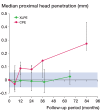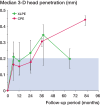Wear of a sequentially annealed polyethylene acetabular liner
- PMID: 25140986
- PMCID: PMC4164863
- DOI: 10.3109/17453674.2014.949044
Wear of a sequentially annealed polyethylene acetabular liner
Abstract
Background and purpose: We previously reported on a randomized controlled trial (RCT) that examined the effect of adding tobramycin to bone cement after femoral stem migration. The present study examined femoral head penetration into both conventional and highly crosslinked polyethylene acetabular liners in the same group of RCT patients, with a minimum of 5 years of postoperative follow-up.
Patients and methods: Linear penetration of the femoral head into an X3 (Stryker) crosslinked polyethylene (XLPE) liner was measured in 18 patients (19 hips) using radiostereometric analysis (RSA). Femoral head penetration was also measured in 6 patients (6 hips) with a conventional polyethylene liner (CPE), which served as a control group.
Results: The median proximal femoral head penetration in the XLPE group after 5.5 years was 0.025 mm with a steady-state penetration rate of 0.001 mm/year between year 1 and year 5. The CPE liner showed a median proximal head penetration of 0.274 mm after 7.2 years, at a rate of 0.037 mm/year.
Interpretation: The Trident X3 sequentially annealed XLPE liner shows excellent in vivo wear resistance compared to non-crosslinked CPE liners at medium-term implantation. The rate of linear head penetration in the XLPE liners after > 5 years of follow-up was 0.001 mm/year, which is in close agreement with the results of previous studies.
Figures


References
-
- Bohm E, Petrak M, Gascoyne T, Turgeon T. The effect of adding tobramycin to Simplex P cement on femoral stem micr... . Acta Orthop. 2012;83(2):115–20. - PMC - PubMed
-
- Bradford L, Baker DA, Graham J, Chawan A, Ries MD, Pruitt LA. Wear and surface cracking in early retrieved highly cross-linked polyeth... . J Bone Joint Surg (Am) 2004;86(6):1271–82. - PubMed
-
- Bragdon CR, Kwon YM, Geller JA, Greene ME, Freiberg AA, Harris WH, et al. Minimum 6-year followup of highly cross-linked polyethylene in THA . Clin Orthop. 2007a;465:122–7. - PubMed
-
- Bragdon CR, Greene ME, Freiberg AA, Harris WH, Malchau H. Radiostereometric analysis comparison of wear of highly cross-linked pol... . J Arthroplasty (Suppl 2) 2007b;22(6):125–9. - PubMed
-
- Bryant D, Havey TC, Roberts R, Guyatt G. How many patients? How many limbs? Analysis of patients or limbs in the ... . J Bone Joint Surg (Am) 2006;88(1):41–5. - PubMed
Publication types
MeSH terms
Substances
LinkOut - more resources
Full Text Sources
Other Literature Sources
Medical
Research Materials
Miscellaneous
